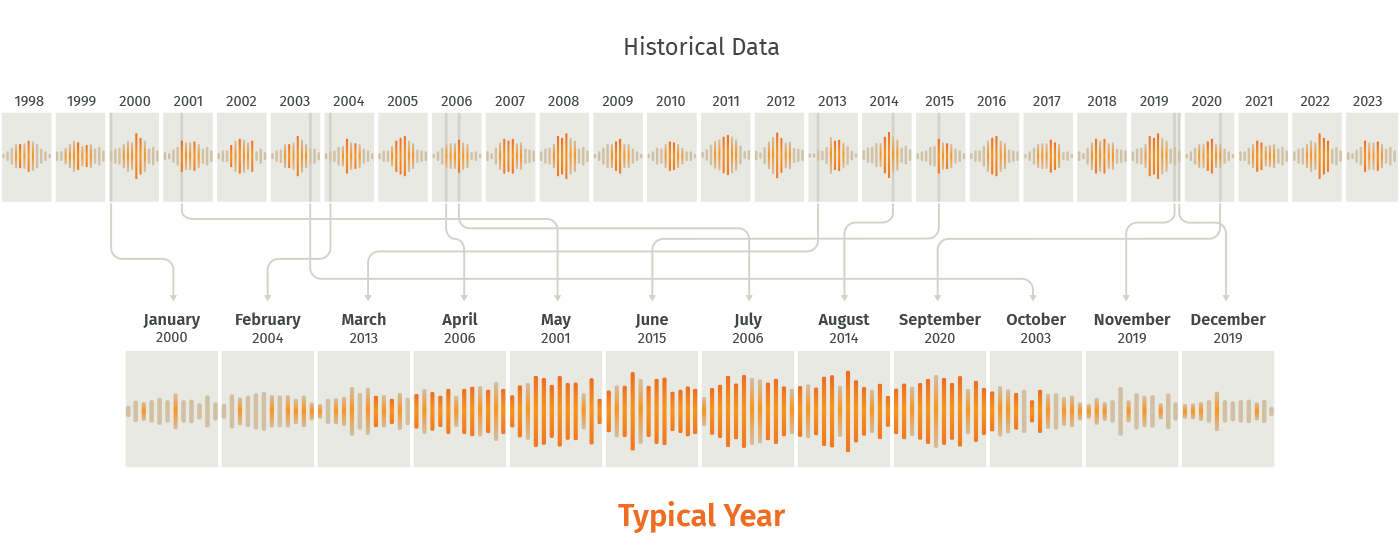SolarAnywhere® Data
Precise, bankable solar irradiance dataFeatures
Accurate
The most accurate and up-to-date satellite-derived solar resource data.
Validated & Trusted
Extensively validated and trusted by hundreds of enterprise-class customers with 2,000+ monthly downloads.
Data On Demand
Flexible delivery options include on-demand data and API access, with full records available (1998 – current day).
Bankability
SolarAnywhere exceeds the standards of bankability.
SolarAnywhere V3.8 Now Available!
The latest version of SolarAnywhere historical data includes updated typical year files (1998–2023), high-latitude irradiance (Typical Year+ exclusive), additional wind data fields and more. Watch this short video or read the blog to learn more.
Solar Data License Types
The Typical Year+ license provides global access to all the same data fields and modeling capabilities as the base Typical Year license, but at the best native resolution available. This results in 100 times more unique data points as compared to the base license.
Typical Year+ is recommended for complex climates (e.g., coastal regions), technical sensitivity analysis, due diligence or anytime lower solar resource uncertainty is required.
- Long-term average solar weather files
- Enhanced resolution (1 km, hourly) around the world1
- Easy-to-use web portal with no additional fees—truly unlimited
- Take advantage of bifacial PV modeling and high-resolution (30m) far-horizon shading to fine-tune your PV modeling
- Easy access to (12 x 1) average snow losses, soiling losses and surface albedo for input into third-party PV modeling tools
- Basic high-latitude irradiance data for quantifying PV production in regions +/-60° and +/-80°
- Sub-hourly TMY irradiance and weather data for enhanced precision in solar energy design and prospecting (15-, 30- and 60-minute interval variations)
What is typical year?
Typical year is a year of hourly meteorological data for a specific location derived from years of historical time-series solar resource data. These data files are commonly used for solar resource availability assessments at potential project sites or running energy simulations to obtain P50 solar production estimates.
Typical Year Data
SolarAnywhere typical year data can be downloaded or requested as either a typical GHI year (TGY) or typical DNI year (TDY) file. These files contain a years’ worth of hourly observations (8760 hourly observations) selected with 100% weighting on either GHI or DNI. The files are generated for a specified location using the following two-step process:
-
- The long-term average monthly total irradiance is calculated for each month. The years considered in calculating the long-term averages is dependent upon the geographic data region:
- The actual months in the historic record with the monthly total irradiance values closest to the long-term averages calculated in step 1 are included in the TGY or TDY files.
- The long-term average monthly total irradiance is calculated for each month. The years considered in calculating the long-term averages is dependent upon the geographic data region:
The final TGY or TDY file will include 12 months of actual data from various years in the historical time series. For example, if January of 2010 has the monthly total irradiance closest to the long-term average monthly total irradiance for all Januarys as calculated in step 1, it will be included in the file. This is illustrated below.

To learn more about Typical Year data, visit our customer support center.
Why Typical Year+?
Watch this short video to learn about the SolarAnywhere Typical Year+ license, which enables access to Typical Year and Average Year Summary irradiance and weather data at the highest native spatial resolution available.
SPECIFICATIONS
1 See SolarAnywhere Geographic Coverage Area for more details.
MOST BANKABLE
SolarAnywhere Sites offers accurate and comprehensive solar data for your project—the most bankable data for PV project financing and asset management.
- Full historical time series; compare to measured data for resource assessment and performance analysis
- Keep your analysis up to date—each site license includes access to the latest data and an on-demand renewal option at reduced operational pricing
- Improve accuracy in complex terrain with enhanced resolution (1 km, 15 min.) data
- Characterize interannual variability with unlimited probability-of-exceedance SolarAnywhere PXX Data downloads
- Refine loss estimates and quantify extreme weather risk with snow losses, precipitation and particulate matter data
- Take advantage of bifacial PV modeling and high-resolution (30m) far-horizon shading to fine-tune your PV modeling
- Evaluate how solar forecasts can improve dispatch algorithms and optimize your PV plant design to deliver firm power with hindcast data
- Assess clipping losses and ramp rates with High-resolution Data with True Dynamics™ (TD), available as an on-demand upgrade (Continental U.S. only)
- Easy access to (12 x 1) average snow losses, soiling losses and surface albedo for input into third-party PV modeling tools
- Sub-hourly TMY irradiance and weather data for enhanced precision in solar energy design and prospecting (15-, 30- and 60-minute interval variations)
SPECIFICATIONS
1 See SolarAnywhere Geographic Coverage Area for more details.
NO-COST ACCESS AT SELECT LOCATIONS
Complete and current SolarAnywhere irradiance and weather data for select locations around the world at no cost.
- Use high-fidelity data at no cost for research, model development, training and more
- Experience on-demand access to complete and current solar data, including enhanced-resolution typical-year and time-series data updated through the trailing day
- Take advantage of the latest SolarAnywhere advancements including bifacial PV modeling and high-resolution (30m) far-horizon shading to fine-time your PV modeling
- Test the full range of data available for industry-leading solar resource assessment and asset management, including: probability of exceedance (PXX) data for weather risk assessment; precipitation and particulate matter data for modeling snow and soiling losses; and hindcast data to optimize plant operation for firm power delivery
- Explore more than 30 global locations, each featuring a city landmark
- Demo the SolarAnywhere web portal and download formats, give the SolarAnywhere API a try and explore integrations with third-party PV modeling tools
- Commercial use not supported
SPECIFICATIONS
1 See SolarAnywhere Geographic Coverage Area for more details.
Ground Tuning Studies
Combine your ground-based measurements with SolarAnywhere® irradiance data to reduce the uncertainty of your solar resource assessments and increase project profitability.
SolarAnywhere Ground-Tuning Studies use an advanced site-adaptation methodology to tune long-term solar resource data to your ground-based measurements.

SolarAnywhere Data Resources

Blog
New SolarAnywhere® monitoring API (beta) joins across-the-board API performance enhancements
Clean Power Research® is excited to announce the public beta release of our new SolarAnywhere monitoring API, designed to provide you with scalable, seamless and efficient access to real-time data. This new, synchronous API supports fast and reliable data retrieval to...
Unlock the power of real-time solar data: New SolarAnywhere® dashboard
Clean Power Research® is excited to unlock the power of real-time solar data for more users with the launch of the SolarAnywhere® SystemCheck® Monitoring Dashboard. Users can now access and visualize SystemCheck real-time irradiance data directly from a user...
Enhancing precision with new SolarAnywhere® sub-hourly TMY data
Clean Power Research® is thrilled to announce the launch of SolarAnywhere® Sub-Hourly Typical Meteorological Year (TMY) irradiance and weather data! This feature provides SolarAnywhere customers with sub-hourly data, enhancing the precision of solar resource...
Reduce solar power forecast uncertainty with SolarAnywhere® Forecast
Solar forecasting solutions for the diverse needs of the solar power industry and utilities. SolarAnywhere Forecast is the solar industry’s leading irradiance forecast paired with trusted PV simulation.



